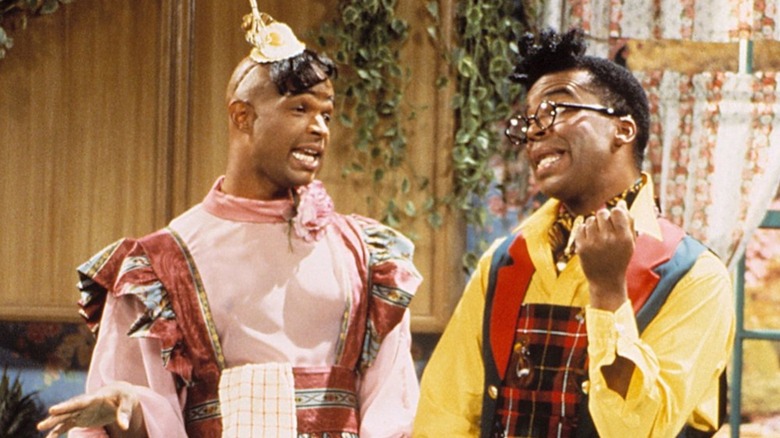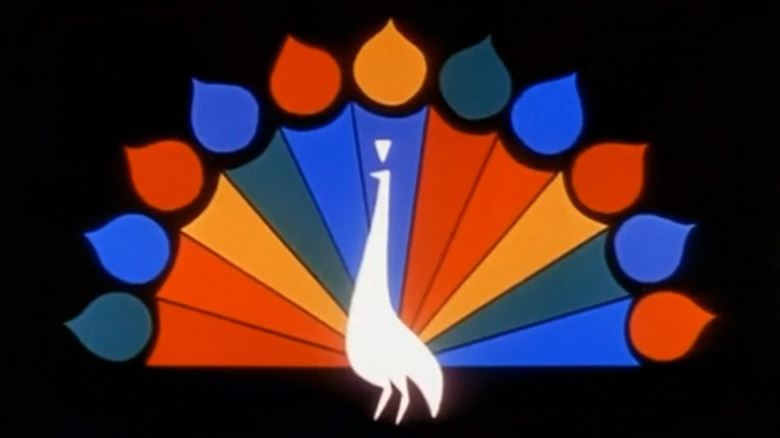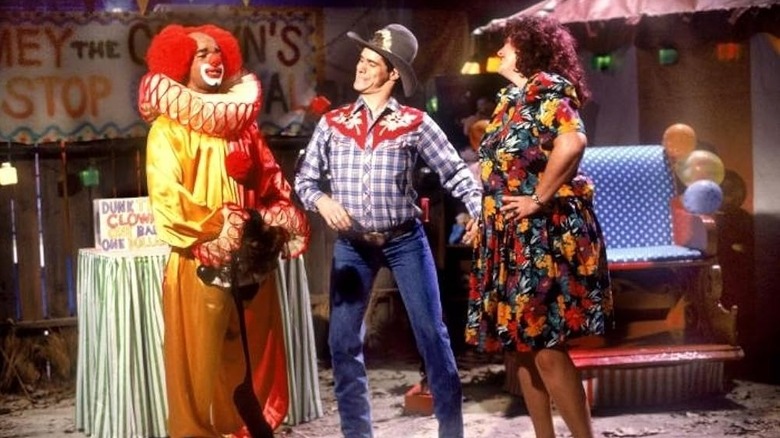The Hit Fox Comedy That Borrowed Its Name From A Decades-Long NBC Tagline
The title of Keenan Ivory Wayans' groundbreaking sketch comedy show "In Living Color" has a double meaning. Most notably, the series featured a cast made up almost entirely of Black comedians, including Wayans, his siblings Damon Wayans and Kim Wayans, Kim Coles, T'Keyah Crystal Keymáh, David Alan Grier, and Tommy Davidson. Jamie Foxx joined the cast later, and both Marlon and Shawn Wayans appeared sporadically. The only white performers in the cast were Jim Carrey (credited as James Carrey) and Kelly Coffield. When compared to the largely caucasian show "Saturday Night Live," Wayans' show was, he declared, in living color.
The phrase "in living color," though, is going to be familiar to those familiar with TV history. Back in the 1950s, the most popular, consumer-grade cathode-ray-tube televisions were still only capable of displaying a grayscale image. While broadcasting color images was a technology that had been in existence for decades, the type of electronic scanning that was required to make it work wasn't feasible, and it didn't work very well. It wouldn't be until 1953 that analog NTSC color TV signals became easier and cheaper to make, and it wouldn't be until the mid-1960s that color-capable TVs would be sold in giant numbers in the United States.
Any TV fans watching NBC in the late 1950s and early 1960s will recall the shift. Indeed, NBC started to brag that their shows were in color, deliberately giving FOMO to anyone who still owned a black-and-white TV. NBC even adopted its famous peacock logo at the time to accentuate that a rainbow of colors awaited anyone who had upgraded to a color TV. For NBC bumpers, the station would broadcast an animation of its peacock, and an announcer would say that the following show was "in living color."
In the 1960s, NBC bragged that their shows were 'in living color'
Specifically, the bumpers said, "The following program is brought to you in living color, on NBC." NBC actually began using the peacock as early as 1957, first seen before an episode of "Your Hit Parade," but most homes still didn't own color TVs at that point. The peacock would become way more popular in the 1960s (as would color TVs), eventually nicknamed the Laramie Peacock, after the 1962 Western series "Laramie." NBC announcer Me Brandt took over vocals. For the rest of the 1960s, the peacock evolved quickly. The phrase "in living color," though, remained.
Color TVs began outselling black-and-white TVs in the mid-1970s. Some kids of the '80s likely recall watching their childhood favorites on black-and-white TVs. They lasted for a long time.
The reason NBC beat the other networks to the punch on color TVs was that, at the time, NBC was owned by RCA, the giant electronics manufacturer. RCA produced color TVs, and they were able to use NBC — and the peacock logo — as a way to advertise their new TV products. Yes, this is a form of insidious vertical integration. The phrase "in living color" (as opposed to the old, dead black-and-white) became a pop culture buzz phrase, and it was used for as long as the Laramie Peacock was. The logo was retired in 1975; by then, it was gauche to brag that your shows were in color. They all were.
The Peacock came back in 1986, and NBC has been using it ever since. Indeed, NBC's streaming service was called Peacock after that logo.
It was a producer's idea to use NBC's phrase for the title of In Living Color
Back in 2019, the Hollywood Reporter printed an oral history of "In Living Color," and the origins of its title became clear. According to Tamara Rawitt, one of the show's producers and writers, it was her idea. She said, quite proudly, that "I actually came up with the title for 'In Living Color,' drafting it off of the fabled NBC tag line."
The phrase "In Living Color" suddenly took on a positive connotation in terms of race. It was no longer about TV broadcast signals or insidious RCA marketing phrases. It was about diversity. Corporate language was repurposed to serve artistic means. It was a welcome change. And "In Living Color" made good on its promise. It's hard to overstate just how important the series felt in the early 1990s. An ultra-hot, very funny hit series with an almost all-Black cast was novel, and Wayans pushed TV forward. Famously, "In Living Color" featured multiple dance numbers every episode performed by their in-house dancers, The Fly Girls. Rosie Perez served as the show's chief choreographer, and Jennifer Lopez was part of the troupe during the show's fourth and fifth seasons.
"In Living Color" lasted for five seasons, going off the air in 1994. By then, however, many of its cast members had gone on to become movie stars (Damon and Marlon Wayans in particular, as well as Jamie Foxx and Jim Carrey). Back in 2012, there was an attempt to revive "In Living Color" with an all-new cast and all-new Fly Girls, but that show was canceled before it could get anywhere. I guess a series can only be groundbreaking once.


